Creating the Work Breakdown Structure
The work breakdown structure (WBS) takes the scope as outlined in the project scope statement and breaks it down into more manageable components called deliverables. It serves as a graphical illustration of the structure of the project and is thus useful as a communication tool for explaining the project to key stakeholders.
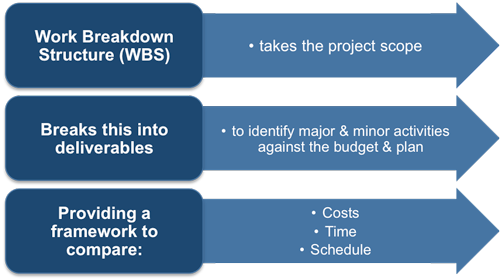 |
The work breakdown structure (WBS) is a hierarchical decomposition of the work to be completed in order to achieve the project deliverables. It defines and structures the total scope of the project because it starts from the deliverables as stated and then decomposes the work and the smaller sections. The number of levels through which this breakdown occurs will be determined by the project size and complexity.
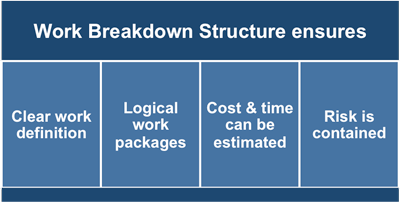 |
This is a key output from project scope management because it determines what work needs to be completed to deliver the objectives of the project. Breaking the work down in a systematic way using the project team reduces the chance of missing anything.
The output produces a graphical representation of the work specified in the project scope statement. The work breakdown structure (WBS) is a unique decomposition of the work generated for each project but a previous WBS can be used as a template for a comparable project because the required deliverables are likely to be similar.
The reason for breaking down the project into manageable and defined sections is to enable a project team to estimate the time and costs for each activity or work package. The review and assessment of smaller work packages will provide a better estimate for the overall cost of the project.
The WBS serves to:
1. Ensure better control of the work definition
2. Allow the work to be delegated in coherent packages
3. Allow the work to be defined at the right level for estimating and control
4. Allow the containment of project risk
Projects are sub-divided in this way for ease of control. Having sub-divided the project, in order to devise a suitably detailed WBS, the project manager will then need to act as the integrator to ensure the practical and timely delivery of the various work elements required.
The creation of the WBS should be one of the first steps in the planning process, once the requirements specification for the project has been written. It should reflect the way the work will be performed and the way in which project costs and data will be summarized and reported.
It provides the framework on which costs, time and schedule performance can be compared against the budget. It also enables the work to be broken down into smaller elements and this should result in the identification of all the activities required by the project. You can check out the complete range of project management pdf eBooks free from this website.
Decomposition is the subdivision of project deliverables into smaller, more manageable components until the work and deliverables are defined to the work package level. The work package level is the lowest level in the WBS, and is the point at which the cost and activity durations for the work can be reliably estimated and managed. The level of detail for work packages will vary with the size and complexity of the project.
Decomposition of the total project work into work packages generally involves the following activities:
1. Identifying and analyzing the deliverables and related work
2. Structuring and organizing the WBS
3. Decomposing the upper WBS levels into lower level detailed components
4. Developing and assigning identification codes to the WBS components
5. Verifying that the degree of decomposition of the work is sufficient
Decomposition of the upper level WBS components requires subdividing the work for each of the deliverables or sub-projects into its fundamental components, where the WBS components represent verifiable products, services, or results.
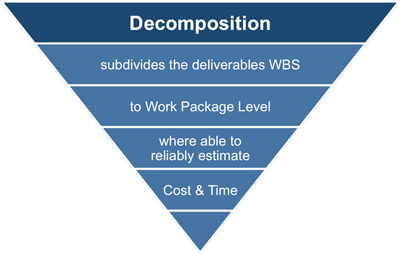 |
The WBS can be structured as an outline, an organizational chart, a fishbone diagram, or other method. Verifying the correctness of the decomposition requires determining that the lower-level WBS components are those that are necessary and sufficient for completion of the corresponding higher-level deliverables.
Different deliverables can have different levels of decomposition. To arrive at a work package, the work for some deliverables needs to be decomposed only to the next level, while others need additional levels of decomposition. As the work is decomposed to greater levels of detail, the ability to plan, manage, and control the work is enhanced. However, excessive decomposition can lead to non-productive management effort, inefficient use of resources, and decreased efficiency in performing the work.
Decomposition may not be possible for a deliverable or sub-project that will be accomplished far into the future. The project management team usually waits until the deliverable or sub-project is clarified so the details of the WBS can be developed. This technique is sometimes referred to as rolling wave planning.
 |
The WBS represents all product and project work, including the project management work. The total of the work at the lowest levels must roll up to the higher levels so that nothing is left out and no extra work is completed. This is sometimes called the 100% rule.
The WBS should be designed and developed carefully as it will typically form the basis for a variety of other aspects of the project environment - for example : project costing, the validation of organizational responsibilities, risk analysis, the coordination of objectives and project control.
Project managers normally manage at the top three levels of the WBS and also provide management reports at this level. Some organizations have attempted to standardize management reports by imposing a generic structure to the top three levels of the structure diagram across all projects. This approach may work in cases where an organization runs a large number of very similar projects - but it is not well suited to the majority of organizations - that run a variety of projects that differ fundamentally in some way.
The WBS typically supports different types of managerial actions at different levels. For example:
Authorization and release of work is generally carried out at level 1
Budgets are normally prepared at level 2
Schedules at level 3
Other characteristics that can normally be applied to different levels of the work breakdown structure include:
1. The top three levels reflect project-wide efforts and should not be related to specific departments, whose efforts should be addressed at lower levels. Each element of work should be assigned to only one level of effort. At the lowest levels the work packages should be identifiable and homogeneous.
2. The term work package is a generic name for a low-level task or job assignment - it describes a discrete piece of work and facilitates the monitoring and reporting of work in progress.
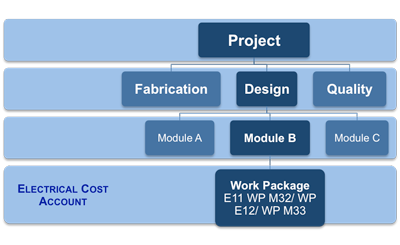 |
3. Different industries and organizations have a variety of strangely named documents for authorizing and assigning work. However, whatever it is called, the work package is the critical component that facilitates management of the WBS. Work packages should be natural subdivisions of effort planned according to the way the work will be carried out.
4. Work packages may be supported by additional documentation, which is generically termed a work package description to ensure that those carrying out, supervising and monitoring the work in progress are clear about exactly what is intended.
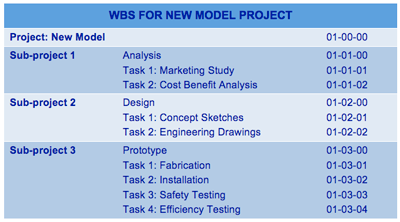 |
This illustration shows a simple WBS and its associated numbering system. The first number represents the total project, the second represents the first sub-project, the third identifies a task within it, and so on. From this table it is easy to see that:
Component numbered 01-03-03 represents task 3 of sub-project 3.
Because so many other aspects of the project depend on the work breakdown structure care should be taken to create an accurate and workable diagram. One of the most important tasks is to ensure that it contains the right number of levels - the consequences of having too many or too few should be apparent.
There are some basic rules to consider when producing a WBS because the resultant diagram achieves a clear indication of the work involved together with an improved level of buy-in from team members due to their involvement with the work and estimation process.
• Ensure that team members assist in drafting the WBS in a systematic way
• Make sure that only the work required to meet project deliverables is included
• Any work not included in the WBS must fall outside of the scope of the project
• The WBS and its support documentation should be easy to understand
• Work should not be subdivided arbitrarily to the lowest possible level.
• WBS elements at the lowest control level should typically range from 0.5% to 2.5% of total project budget.
• No task should be less than 8 hours or more than 80 hours.
The WBS is an absolutely critical document and the success of the project depends upon it being done thoroughly.
The WBS Dictionary is a document generated that provides more detailed descriptions of the components in the WBS, including work packages and control accounts.
The WBS is input to most of the planning processes, for example:
• Cost Estimating
• Cost Budgeting
• Scope Control
• Activity Definition
• Plan Purchases and Acquisitions
Furthermore, you should be aware that the WBS can be developed to reflect the trust that you have in specific line groups, by leaving them the autonomy over specific areas of work. Finally, always remember that projects are dynamic working environments, so try to maintain flexibility wherever possible.
A great deal of work is required to produce a comprehensive WBS but the benefits of using this approach mean there is less chance of work being missed. The project team will also have a better understanding of the work together with the knowledge of whether element fits into the overall scheme.
Dissemination of the WBS to all stakeholders will maintain the cooperation and communication link, which may in turn help manage the project and expectations. Another vital benefit is the team's buy into the document for the opportunity to ensure everyone remains focused on the output of the project.
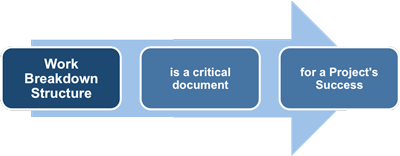 |
Once the WBS has been completed it then becomes a valuable tool for the overall management of the project. It is of particular use when you need to evaluate the impact of a requested change in scope and also when reassessing the scope of the project due to an approved change. The WBS is critical in controlling the scope because if something is not within the WBS then it is outside of the scope of the project.
In summary, The work breakdown structure (WBS), is a description of all the deliverables to be provided in fulfillment of the project. Creating it is the process of subdividing project deliverables and project work into smaller, more manageable components that provide a structured vision of what has to be delivered. The WBS is a list of deliverable items to give the project team a visual of the work to be accomplished.
You may also be interested in:
Project Scope Management | Scope Creep and Project Change Control | Planning How to Manage the Project Scope | Documenting the Project Requirements | Creating a Project Scope Statement | Creating the Work Breakdown Structure | Validating and Controlling Project Scope.
|
|


